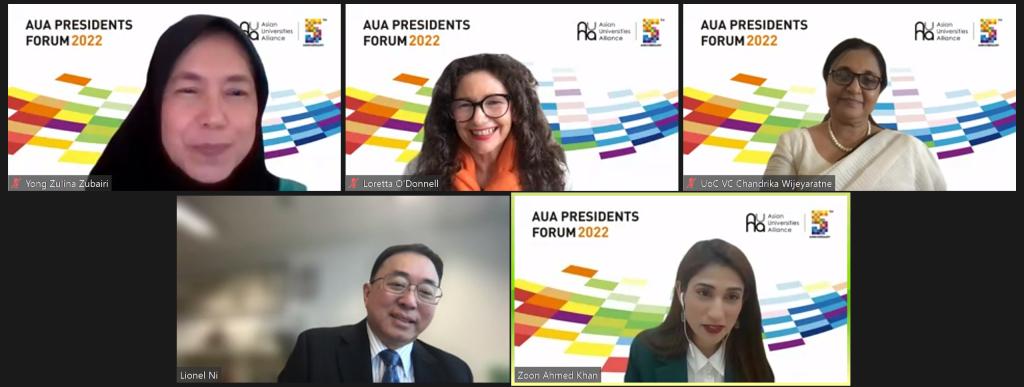Why is interdisciplinarity the emerging and desirable trend in higher education? What strategies are Asia’s leading universities exploring to promote interdisciplinarity? How can the ‘future of learning’ meet the new demands of the rapidly evolving society?
These were some of the critical questions examined in the third session of Asian Universities Alliance Presidents Forum (AUAPF) 2022 “Future of Learning: Interdisciplinary Education and Innovative Pedagogy”. The panel included Prof. Lionel Ni, President of The Hong Kong University of Science and Technology (Guangzhou); Prof. Chandrika Wijeyaratne, Vice Chancellor of the University of Colombo; and Dr. Loretta O’Donnell, Vice Provost of Nazarbayev University. Prof. Yong Zulina Zubairi, Associate Vice-Chancellor Universiti Malaya, moderated the session.

In her opening remarks, Prof. Zubairi noted that the complex and multifaceted nature of emerging challenges warrants the need for imaginative solutions. “Universities thus have a vital role to play as we seek effective solutions,” she said. “Transcending disciplinary boundaries and incorporating multiple perspectives can take us a long way.” The panel discussion that followed assessed the strategies as well challenges universities face in their quest to promote interdisciplinary education and innovative pedagogy.
Creating Synergy
For universities to strike a balance between “theory and practice” as well as “depth and breadth” is as crucial as it is challenging. Interdisciplinary education needs to be geared towards bridging these gaps through innovative curriculum development and engaging real world problem-solving. According to Dr. O’Donnell, “When we think about interdisciplinarity in terms of education, we essentially think of the word synthesis,” so the question that needs to be asked is, “How do we look at a range of different mental models and synthesize them to come up with complex answers to the complex questions.” Consequently, Nazarbayev University (NU) strives to build on the concept of the “T-shaped student”, who possesses knowledge spread across a range of disciplines, but also holds depth in a certain specialization. This approach is meant to equip graduates with the ability to solve problems from a range of different perspectives. NU’s compulsory core curriculum that includes ethics, writing and history is designed to achieve exactly this.
O’Donnell also reflected on the dichotomy between successful academic careers, that incentivise scholars to specialise in a very narrow field, and the complex thinking skills required to tackle practical challenges such as climate change, gender equality, public health and issues of well-being. By allocating collaborative research grants, NU is encouraging scholars to pursue multi-disciplinary studies. As a national university, NU’s mandate also includes cross-institutional collaborations with other universities in Kazakhstan. O’Donnell emphasized that a collaborative culture “is a step forward to many things, from solving a particular research problem, towards creating more harmony and more understanding across cultures.”
Pushing Boundaries
On “budgets and boundaries”, President Ni of The Hong Kong University of Science and Technology (Guangzhou) (HKUST(GZ)) offered a candid assessment. “Whereas all higher education practitioners know the importance and benefits of collaborations, when you come down to budget allocation and performance assessment, boundaries come into play,” he said. He explained that the establishment of HKUST (GZ) creates an exceptional opportunity for new resources, organizational structure and physical settings needed for the systematic development of cross-disciplinary programs in concert with the disciplinary-oriented efforts at HKUST’s Clear Water Bay campus. At HKUST (GZ), cross-disciplinary education and research will be realized through four “hubs”, namely, function hub, information hub, systems hub, and society hub. The university encourages theme-based labs which are accessible to all the interested faculty and students. Ni also firmly advocated randomly-allocated and multidisciplinary spaces for faculty members, “I don't say this department or that department. The person next door may be from a different discipline, which allows them to communicate.”
Promoting innovation through interdisciplinary work is key to education at HKUST (GZ). Ni noted, “We encourage students to learn from different disciplines. Graduate student, especially PhD students, need dual advisors from different disciplines.” Commenting on the impact of COVID-19 on education, he asserted that by forcing universities out of their comfort zones, the pandemic has offered a unique opportunity. “We had no choice; we stuck on to further improve, to a point where I think we're effective now,” he remarked while describing the speed with which online teaching was eventually embraced. Despite initial reluctance and scepticism from faculty and students, “today our evaluation of online classes is better than the traditional classroom,” he noted. Ni also stressed that ultimately a mindset-change is very important to “making a change, and making an impact.”
Towards Problem-Solving
While assessing the system of exam-based learning in many Asian societies, Vice Chancellor Wijeyaratne noted that this culture needs to change. To shift away from traditional learning methods and encourage “out of the box” thinking, the University of Colombo (UoC) has established staff development centres and young academic mentoring initiatives. “We reviewed this situation because we had a little more time during this pandemic,” she discussed, further elaborating that a “new reality” has opened the eyes of young professionals to new opportunities, with more focus on real-world challenges. UoC has responded by expediting education in more practical sectors, increasing emphasis on emerging fields such as entrepreneurship, and establishing better connections between job providers and the university.
According to Wijeyaratne, “The goal for universities should move beyond ‘simply teaching or learning’ and instead include practical application, and to equip students with enough flexibility to change their course over time in order to achieve richer career outcomes.” UoC has encouraged different competitions and created new avenues to inspire students and faculty members to connect with the real world and evolving trends in the job market.
All panellists agreed that today universities find themselves on a fast track to think about academia differently and more holistically. In this light, Asian universities have a unique opportunity to transcend disciplinary boundaries and incorporate multiple perspectives in finding viable and imaginative solutions for a better world.
Writer: Zoon Ahmed Khan